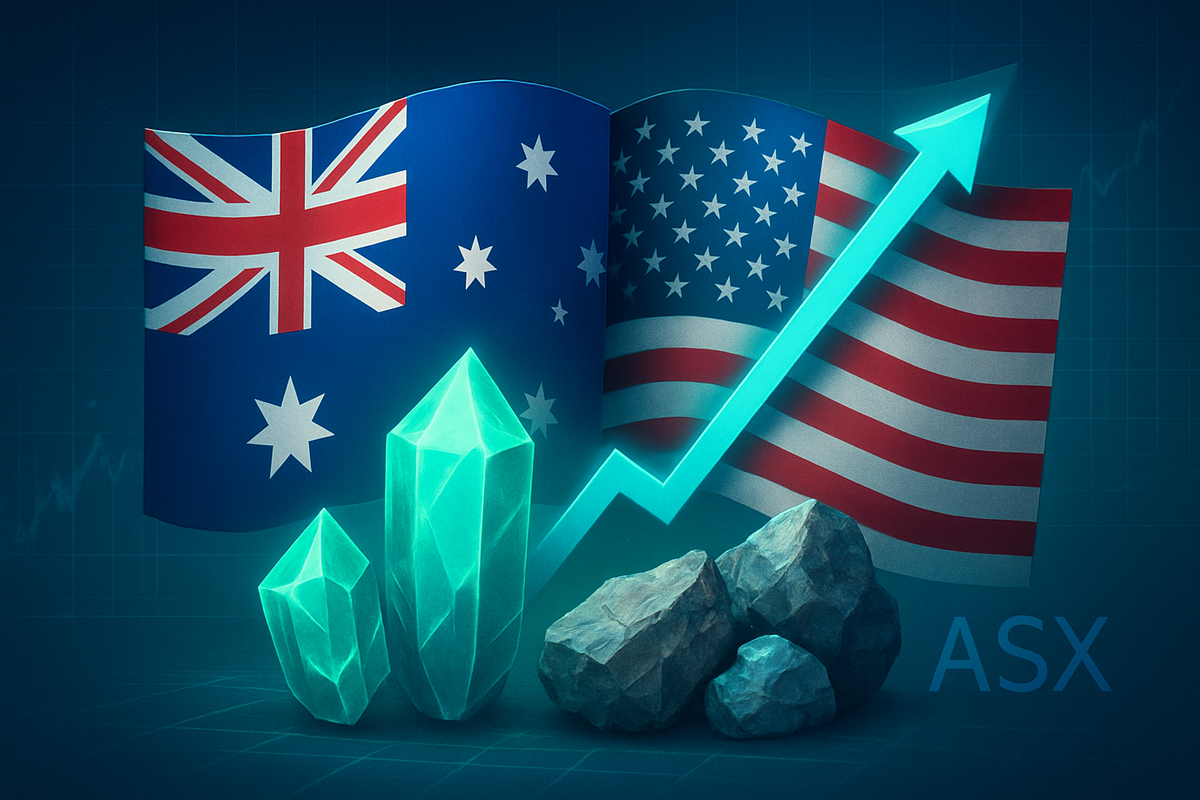
The strategic alliance between Australia and the United States, formalized on October 20, 2025, marks a pivotal moment in global critical minerals supply chain security. This landmark partnership is poised to inject billions into the Australian lithium and rare earths sectors, fundamentally reshaping the investment landscape on the Australian Stock Exchange (ASX) and positioning Australia as a vital Western processing hub. The agreement, designed to de-risk essential supply chains and diminish reliance on single-source nations, especially China, transforms critical minerals from mere commodities into national security assets.
This collaboration is set to unlock significant investment opportunities, with both nations committing substantial capital towards accelerating exploration, mining, and advanced processing capabilities. For ASX-listed companies operating in the lithium and rare earths space, this translates into unprecedented access to funding, streamlined regulatory pathways, and enhanced strategic importance, fostering a new era of growth and innovation.
A New Era of Strategic Resource Security
The Australia-US critical minerals partnership is a comprehensive framework covering the entire supply chain, from geological exploration to the production of manufacturing-ready materials. Key elements of this agreement include a commitment to jointly invest over US$3 billion within six months, targeting projects that could unlock an estimated US$53 billion worth of resources. An initial financing target of at least US$1 billion from each nation has been set for projects in their respective territories, with the US Export-Import Bank (EXIM) already issuing over US$2.2 billion in financing letters of interest for US critical mineral projects in Australia.
This partnership is driven by a shared recognition that vulnerabilities in critical mineral supply chains pose significant risks to both commercial and defense industries. The agreement includes commitments to streamlined permitting processes and enhanced project support, designed to accelerate development timelines for strategically important operations. Furthermore, it facilitates technology transfer and innovation, promoting knowledge sharing in advanced processing techniques to improve recovery rates and reduce environmental impacts. A US-Australia Critical Minerals Supply Security Response Group, comprising cabinet-level officials, has been established to identify vulnerabilities and expedite mineral delivery. The scope of minerals covered is extensive, including lithium, rare earth elements, gallium, magnesium, and scandium, all vital for electric vehicles, renewable energy, and defense technologies.
The formalization of this partnership on October 20, 2025, culminates years of growing concern over critical mineral dependencies and aligns with broader initiatives such as Australia's Critical Minerals Strategy and the US-led Minerals Security Partnership (MSP). These efforts underscore a coordinated international push to establish resilient, diversified supply chains. Initial market reactions have been largely positive, with increased investor confidence anticipated for ASX-listed critical minerals companies due to the enhanced government backing and strategic importance now attributed to these resources.
ASX Winners in the Critical Minerals Race
The Australia-US critical minerals partnership is set to significantly benefit numerous ASX-listed companies, particularly those with established operations or advanced projects in lithium and rare earths. These companies are now strategically positioned to receive substantial capital injection, government support, and preferential market access.
In the lithium sector, Pilbara Minerals (ASX: PLS) stands out. Despite challenging price conditions in the past, the company has consistently achieved record spodumene concentrate output and maintains substantial cash reserves, providing flexibility to capitalize on future lithium price recoveries. The partnership's focus on supporting viable Western mining operations and creating more balanced global markets for critical minerals directly benefits Pilbara Minerals by reinforcing demand and stability. Similarly, companies involved in expanding lithium hydroxide and carbonate processing capacity within Australia are poised for growth, transforming Australia's raw material dominance into downstream processing capabilities.
For rare earth elements, the partnership directly targets China's overwhelming control of processing and refining. Lynas Rare Earths (ASX: LYC), as the only significant rare earth producer outside Chinese control, holds a unique strategic position. It produces neodymium-praseodymium (NdPr), crucial for EV motors and wind turbines, and achieved a significant milestone in May 2025 by producing commercial quantities of dysprosium oxide outside China. Lynas has also inked a memorandum of understanding with US-based Noveon Magnetics to develop a scalable US supply chain for rare earth permanent magnets. Other key beneficiaries include Arafura Rare Earths (ASX: ARU), whose Nolans Project in the Northern Territory, focusing on light rare earths like NdPr, is construction-ready and has secured substantial government funding, including an A$200 million injection from Australia's National Reconstruction Fund Corporation and a US$100 million equity investment from the Australian government, alongside EXIM financing. Iluka Resources (ASX: ILU), with its established mineral sands production, is developing rare earth refining capabilities at Eneabba, Western Australia, backed by a A$1.25 billion government loan, with first production expected in 2027. Northern Minerals (ASX: NTU), with its Browns Range Project focusing on heavy rare earths like dysprosium and terbium, is also a recipient of EXIM financing, highlighting its strategic importance for defense and high-temperature magnet applications. Additionally, VHM, with its project in Victoria, will supply rare earth elements, zircon, and titanium minerals, contributing heavy rare earth feedstock for supply-chain resilience. Beyond these major players, the US Department of Defense is investing in a 100-metric-ton-per-year gallium refinery at Alcoa's (ASX: AWC) Wagerup facility in Western Australia, with Australian government investment of up to US$200 million, further diversifying the critical minerals landscape. Macquarie analysts have also tipped emerging players like St George Mining Ltd (ASX: SGQ), Meteoric Resources Ltd (ASX: MEI), and Image Resources (ASX: IMA) for their critical mineral exposure and potential to outperform.
Broader Geopolitical and Economic Implications
This Australia-US critical minerals partnership transcends mere economic cooperation; it is a profound geopolitical statement aimed at reshaping global supply chains and reducing strategic vulnerabilities. The alliance directly addresses the West's over-reliance on China for the extraction and processing of critical minerals, a dependency that has raised significant national security concerns. By fostering integrated, resilient supply chains, the partnership aims to diversify sources and establish alternative processing hubs outside of China, thus mitigating geopolitical risks and enhancing economic stability for allied nations.
The initiative fits squarely into broader industry trends emphasizing "friend-shoring" and the development of secure, ethical supply chains for materials vital to the green energy transition and advanced technologies. The potential ripple effects are substantial, encouraging other nations to invest in similar partnerships and driving a global re-evaluation of critical mineral sourcing strategies. This could lead to increased competition in new exploration and processing technologies, as well as a greater focus on environmental, social, and governance (ESG) standards within the mining sector globally. Regulatory and policy implications are significant, with both governments committing to streamlined permitting processes and substantial financial backing, which will likely set new precedents for government involvement in strategic industries. This aligns with Australia's "Future Made in Australia" plan, which seeks to boost domestic manufacturing and processing capabilities. Historically, such strategic alliances for vital resources have often emerged during periods of geopolitical tension, reminiscent of Cold War-era efforts to secure energy and strategic metals, underscoring the long-term importance and potential for lasting impact.
The Road Ahead: Opportunities and Challenges
Looking ahead, the Australia-US critical minerals partnership is set to accelerate project development and foster significant new investments in Australia's critical minerals sector. In the short term, we can expect a flurry of activity as companies seek to capitalize on the pledged government funding and streamlined processes. This will likely manifest in increased exploration efforts, expansion of existing mining operations, and, crucially, the rapid development of advanced processing facilities for lithium and rare earths within Australia. The emphasis on downstream processing represents a strategic pivot for many Australian companies, moving beyond raw material extraction to higher-value-added activities.
Long-term possibilities include the establishment of Australia as a globally significant, secure, and sustainable hub for critical mineral supply. This could attract further international investment beyond the US, as other allied nations seek to diversify their own supply chains. Market opportunities will emerge for technology providers, engineering firms, and logistics companies supporting the expanded critical minerals ecosystem. However, challenges remain, including the inherent volatility of commodity markets, the need for a skilled workforce, and ongoing environmental considerations. While the partnership aims to stabilize markets, global demand fluctuations and potential retaliatory measures from dominant producers could still introduce short-term price swings. Nevertheless, the strategic value of these minerals, driven by sustained demand from electric vehicles, renewable energy, and defense sectors, is expected to underpin long-term growth and resilience.
A Transformative Partnership for a Secure Future
The Australia-US critical minerals partnership represents a monumental shift in the global quest for secure and diversified critical mineral supply chains. The key takeaway is the elevation of these essential materials to national security assets, driving unprecedented levels of government support and strategic investment. For the ASX, this translates into a fundamentally transformed investment landscape, where companies in the lithium and rare earths sectors are positioned for accelerated growth and enhanced stability.
Moving forward, the market will likely exhibit a dual nature: continued short-term volatility influenced by global supply-demand dynamics and geopolitical events, juxtaposed with a robust long-term outlook underpinned by strategic government backing and sustained demand. Investors should closely watch for project milestones, further government funding announcements, and the progress of advanced processing facilities. The lasting impact of this partnership will be the creation of a more resilient, diversified, and ethically sourced critical minerals supply chain, bolstering Western economic and national security for decades to come.
This content is intended for informational purposes only and is not financial advice





